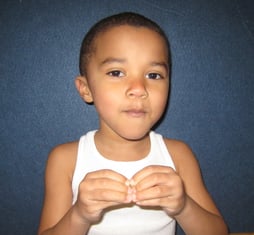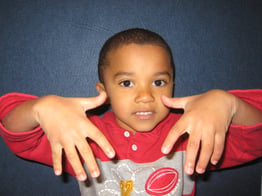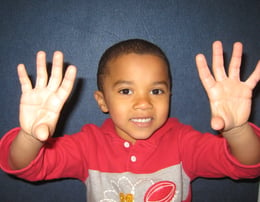By Carol Garboden Murray
You don’t need to take a sign-language class to begin using signs with babies and toddlers. With these two signs, more and all done, you can go miles in supporting communication and language development.
Before a baby can speak, she can communicate her needs by gesturing, gazing with her eyes, using facial expressions, kicking her feet, waving her arms when she is happy or throwing and pushing when she is upset. When we look at how babies communicate naturally, we see the two basic needs they want to express:
More
“I like that." “I want more of that!” “That makes me happy!” “Give it to me!”
All Done
“No." “I don’t want it!” “Stop!” “Take it away!”

To sign more, bring hands together and gently tap fingertips together repeatedly.


To sign all done, move hands outward with a flip as if finished with something. Imagine clearing the table or pushing something away.
Learn these two simple signs, and use them consistently throughout the day. The wonderful thing about using more and all done with babies and toddlers is that it reduces communication frustration and supports caring relationships. Perfect opportunities to use these signs occur naturally all day long:
- Meals: When baby or toddler looks to you with an mouth open to indicate she wants more, or when a toddler points or grunts to get more snack, model the sign for more as you say the word and meet the child’s desire. After the child sees you model this sign several times, you can pause slightly and anticipate the child’s imitation. Offer gentle assistance by helping the child bring her hands together while you repeat the word more (similar to the way we teach babies to gesture by helping them wave bye-bye). When the baby or toddler turns his head away or attempts to get up or throw food to indicate he is finished, take the opportunity to say, “I see you are all done”, as you produce the sign all done.
- Play Time: During novel and engaging activities such as blowing bubbles, playing peekaboo, or pushing the child on a swing, pause slightly and look for the child’s nonverbal cue that he wants more. When he shows interest by giving eye contact, kicking his legs, or laughing, you have the perfect opportunity to say, “Oh, I see you want more,” as you model the sign more. When the child whines, grunts, protests, or moves away to indicate he is finished playing, model the sign all done to allow him the opportunity to learn how to express himself with words and gestures.
- Transitions and Closure: When play time is over, begin to put the toys away and sign all done. This visual cue gives children a tangible preparation for a transition and helps them learn a routine. As you finish an activity such as changing the child’s diaper say and sign all done. This can help the child learn signs as part of a daily ritual, and the child will anticipate the signal instead of struggling during diaper change.

This post was contributed by Carol Garboden Murray, author of Simple Signing for Young Children. Carol has been working with children and families for many years in infant, toddler, and preschool education and early intervention. She is currently the director of child care services at Dutchess Community College in Poughkeepsie, NY. You can visit her at carolgarboden.com or email her at murray@sunydutchess.edu.
Author(s)Carol Garboden Murray
Ashleigh Craven
Ashleigh Craven has a decade and a half of diverse category experience from agency communications to athletic apparel to automotive to education, developing and executing communication strategies in both traditional and social media. She has supported national product launches and corporate events for the likes of Soffe, Buick, Chevrolet, Wake Forest University , Kaplan, and others. She has an BA from the University of Michigan in English and Communication Studies and an MA from Wake Forest University, where she focused her studies on argumentation and presidential rhetoric and speechwriting. She served as director of marketing for Gryphon House from 2017- 2020.